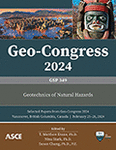A Semi-Analytical Framework to Simulate the Motion of Creeping Landslides
Publication: Geo-Congress 2024
ABSTRACT
Landslide initiation, movement, and arrest are controlled by coupled hydro-mechanical processes. In this paper, a modeling framework solving the coupling between excess pore pressure dissipation and the landslide sliding dynamics is discussed. The model focuses on the basal shear zone, where inelastic deformation and displacement concentrate. The framework simulates the entire life cycle of a landslide, from triggering to runout, and enables a versatile incorporation of multiple inelastic constitutive laws. With these features, the framework can be used to capture different trends of landslide motion, from episodic events with velocity lower than 1 m/year to highly mobile runaway failures faster than 10 m/s. Here the framework is tested with perfect plastic frictional behavior. It is shown that closed form analytical solutions can be recovered. Notably, it can be shown that at steady state, a creeping landslide moving under the effect of sustained hydrologic forcing can be depicted as an equivalent damper with a viscosity dictated by the hydro-mechanical couplings in the shear zone. Specifically, our analyses show that triggering and propagation are dominated by a small number of characteristic timescales, including those controlling the time of consolidation, shear wave propagation, and viscous soil response. In the presence of dilation, negative excess pore pressure regulates the landslide mobility resulting in stable seasonal creep. By contrast, vanishing dilation (i.e., critical state) leads to sharp acceleration and large runout. In addition, for liquefiable soils (negative dilation), we show that small shear pulses can lead to self-feeding excess pore pressure buildup if the load is imposed faster than a critical rate. The satisfactory performance displayed by the model in simulating several case studies corroborates its versatility to support the interpretation of slope movement patterns and the assessment and mitigation of landslide hazards.
Get full access to this article
View all available purchase options and get full access to this chapter.
REFERENCES
Berti, M., and Simoni, A. (2010). Field evidence of pore pressure diffusion in clayey soils prone to landsliding. Journal of Geophysical Research: Earth Surface, 115(F3).
Buscarnera, G., and Whittle, A. J. (2012). Constitutive modelling approach for evaluating the triggering of flow slides. Canadian Geotechnical Journal, 49(5), 499–511.
Chen, Y., and Buscarnera, G. (2021). Numerical simulation of unstable suction transients in unsaturated soils: the role of wetting collapse. International Journal for Numerical and Analytical Methods in Geomechanics.
Chen, Y., and Buscarnera, G. (2022). Unified modeling framework of flowslide triggering and runout. Géotechnique, 1–37.
Handwerger, A. L., Huang, M.-H., Fielding, E. J., Booth, A. M., and Bürgmann, R. (2019). A shift from drought to extreme rainfall drives a stable landslide to catastrophic failure. Scientific reports, 9(1), 1–12.
Handwerger, A. L., Roering, J. J., and Schmidt, D. A. (2013). Controls on the seasonal deformation of slow-moving landslides. Earth and Planetary Science Letters, 377, 239–247.
Hendron, A., Jr., and Patton, F. D. (1985). The vaiont slide. A geotechnical analysis based on new geologic observations of the failure surface. Volume 1. Main text. Retrieved from.
Hungr, O. (2007). Dynamics of rapid landslides. In Progress in landslide science (pp. 47–57): Springer.
Hutchinson, J. (1986). A sliding–consolidation model for flow slides. Canadian Geotechnical Journal, 23(2), 115–126.
Iverson, R. M. (2005). Regulation of landslide motion by dilatancy and pore pressure feedback. Journal of Geophysical Research: Earth Surface, 110(F2).
Iverson, R. M., and Major, J. J. (1987). Rainfall, ground-water flow, and seasonal movement at Minor Creek landslide, northwestern California: Physical interpretation of empirical relations. Geological Society of America Bulletin, 99(4), 579–594.
Iverson, R. M., Reid, M., Iverson, N. R., LaHusen, R., Logan, M., Mann, J., and Brien, D. (2000). Acute sensitivity of landslide rates to initial soil porosity. Science, 290(5491), 513–516.
Keefer, D. K., and Johnson, A. M. (1983). Earth flows; morphology, mobilization, and movement (2330-7102). Retrieved from.
Li, X., Chen, Y., Handwerger, A. L., and Buscarnera, G. (2023). Dynamics of creeping landslides controlled by inelastic hydro-mechanical couplings. Engineering geology, 317, 107078.
Mansour, M. F., Morgenstern, N. R., and Martin, C. D. (2011). Expected damage from displacement of slow-moving slides. Landslides, 8(1), 117–131.
Oberender, P. W., and Puzrin, A. M. (2016). Observation-guided constitutive modelling for creeping landslides. Géotechnique, 66(3), 232–247.
Song, Z., Li, X., Lizárraga, J. J., Zhao, L., and Buscarnera, G. (2020). Spatially distributed landslide triggering analyses accounting for coupled infiltration and volume change. Landslides, 17(12), 2811–2824.
Wood, D. M. (2004). Geotechnical Modelling (Applied geotechnics; v. 1): Taylor & Francis Group/Books.
Information & Authors
Information
Published In
History
Published online: Feb 22, 2024
ASCE Technical Topics:
- Continuum mechanics
- Coupling
- Creep
- Dynamics (solid mechanics)
- Elasticity and Inelasticity
- Engineering mechanics
- Geohazards
- Geomechanics
- Geotechnical engineering
- Landslides
- Material mechanics
- Material properties
- Materials characterization
- Materials engineering
- Mechanical properties
- Motion (dynamics)
- Pore pressure
- Pressure (type)
- Rheology
- Seismic waves
- Shear waves
- Soil analysis
- Soil mechanics
- Soil properties
- Solid mechanics
- Structural engineering
- Structural members
- Structural systems
- Waves (mechanics)
Authors
Metrics & Citations
Metrics
Citations
Download citation
If you have the appropriate software installed, you can download article citation data to the citation manager of your choice. Simply select your manager software from the list below and click Download.
